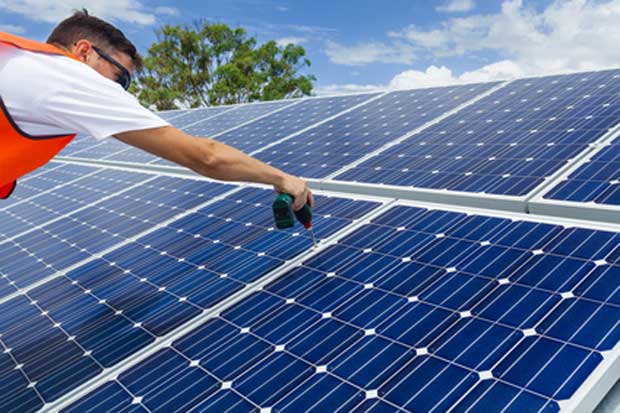A report published by the Grattan Institute on Monday has been dismissed by the solar industry, which argues its critique of generous state and federal government subsidy schemes misrepresents their true value and ignores important flow-on benefits.
The report claims that by 2030 electricity consumers without solar panels will have effectively subsidised homes that took advantage of the schemes to the tune of $9 billion.
Rather than governments paying for the subsidies off their budgets “it was basically being done by putting up the cost of electricity to everybody”, said report author Tony Wood.
Because electricity prices are set by peak time demand, which typically occurs in the early evening when solar homes usually still rely on the traditional grid, households with rooftop solar have pushed up costs but escaped higher charges during the day, when their solar panels were producing energy.
On top of this, high feed-in tariffs which incentivise solar homes to sell excess electricity back to the grid have unfairly advantaged those who could afford the “prohibitive” up-front costs of solar panels and installation, the report said.
“In some ways it was quite an insidious but politically attractive way to achieve something that the government didn’t have to pay for,” Wood told Radio National.
Unsurprisingly, the solar industry has taken a dim view of the report with the Chief Executive of the Australian Solar Council, John Grimes, accusing Wood of “cherry picking” facts.
“It’s a selective report designed to cast solar PV in the worst possible light,” he said.
The report “looks particularly at the period between 2008 and 2010,” a time which Grimes admits was characterised by “overly generous feed-in tariffs in some states”.
“It was a low watermark in solar policy in Australia,” he said.
“We had two pilots in the cockpit, one from the state and one from the federal government,” he said. “There was a wall between them and they were talking to different control towers.”
The key criticism made by the report, that non-solar electricity users were cross-subsidising homes with solar photovoltaic rooftops, also came under fire for its “selective scope”.
“It talks about cross-subsidies for solar PV owners, but this report does not talk about or quantify subsidies from people who have air conditioners, to people who don’t; people who live in our cities, to the people who live in the bush; to residential customers versus commercial customers,” Grimes said.
“The more energy you use in Australia, the lower you pay, right, so big companies pay a fraction of what mum and dads do. That’s a massive cross-subsidy.
“It’s fine to be harry hindsight, to go back in time and then project that forward over 21 years out to 2030, come up with a headline figure of $9 billion and make it sound like, in some way, this is a planned economy and we had $9 billion in the bank, we wanted to deploy it to get a particular outcome.”

When New Matilda put the industry’s criticisms to Wood on Tuesday he defended his work, arguing the report is simply an objective economic analysis of the policies’ effectiveness.
Wood particularly reiterated the report’s findings that subsidising rooftop solar has done little to bring down emissions, contributing just 10 per cent to the federal government’s 2020 reduction target of five per cent on 2000-level emissions.
“I would be proud if we had a clear, firm climate change policy which was actually going to reduce Australia’s emissions to meet a target which was a much tighter target than we have now,” he said.
“If solar is part of the way to meet this target at lowest cost then I’m all for it.” His calculation, however, that subsidising rooftop solar cost $175 per tonne of carbon abatement suggested that’s simply not the case yet.
In spite of this, the solar roll-out has had significant flow-on benefits according to the Chief Executive of the Clean Energy Council, Kane Thornton.
“It is important to recognise that the government support provided to solar power has leveraged billions of dollars in private investment to date,” Thornton said.
“They will have delivered approximately $30 billion in total investment by 2028, the same period examined by the Grattan Institute report.
“This support has also created over 13,000 jobs in the solar sector, particularly in regional and rural parts of Australia, where employment opportunities are otherwise limited.
"The Grattan Institute report ignores the value of these jobs,” Thornton said.
But Wood has also dismissed these assertions: “To suggest that a benefit for the subsidies [is]to create jobs is a highly questionable use of public funds,” he said.
“There’s all sorts of ways jobs can be created and it’s pretty obvious that until the cost of solar comes down this isn’t a sustainable industry, so those jobs haven’t been sustainable.
“I don’t deny for a second we’ve created an industry, but the question is was it a good use of public funds to create this industry at this particular time.”
While Wood argues that solar rooftops are still for the most part uneconomic without subsidies, he has found some middle ground with the industry in his agreement that developments in storage battery technology mean the rise of solar is “inexorable”.
“It’s not useful to talk about the cost of an industry or where it’s come from because all industries require support to establish themselves,” said Claire O’Rourke, the National Director of the Solar Citizens group which advocates for solar homeowners.
She said Wood’s “numbers game” disregards the opportunities that arise from the deployment of solar photovoltaic technology to 1.4 million Australian rooftops.
As the nation with the highest deployment of rooftop solar “we’re now in an envious position” to capitalise on developments in storage technology, O’Rourke said.
There has been a lot of excitement around recent developments in battery technology, particularly Tesla’s release of a significantly cheaper battery which has been widely heralded as a game-changer that will allow people to get off the grid.
“Certainly I think what we need to keep in mind is that as storage technology becomes more economic, this is what will actually change the entire conversation around our electricity system,” O’Rourke said.
Donate To New Matilda
New Matilda is a small, independent media outlet. We survive through reader contributions, and never losing a lawsuit. If you got something from this article, giving something back helps us to continue speaking truth to power. Every little bit counts.




